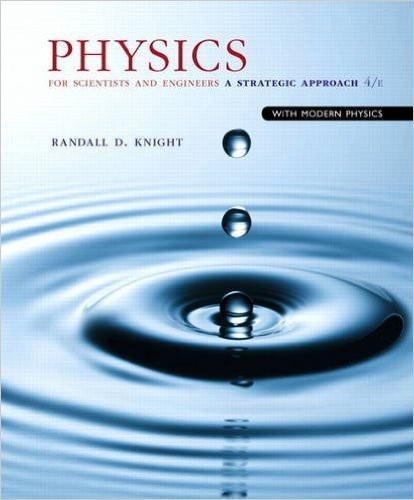
Physics For Scientists And Engineers: A Strategic Approach, 4th Edition
Authors: Randall D. Knight
ISBN-13: 978-0133942651
See our solution for Question 39P from Chapter 7 from Randall Knight's Physics for Scientists and Engineers.
Problem 39P
Chapter:
Problem:
Figure shows a block of mass m resting on a 20° slope. The block has coefficients of friction...It is connected via a massless string over a massless, frictionless pulley to a hanging block of mass 2.0 kg...
Step-by-Step Solution
Step 1
Given Data
Mass of block on slope = $m$
Coefficient of static friction = $\mu_s = 0.50$
Coefficient of kinetic friction = $\mu_k = 0.80 $
Slope inclination = $\theta = 20^\circ $
Mass of hanging block = 2.0 kg
We have to find the following:
(a) Minimum mass, m that will not slip
(b) Acceleration when motion starts
Step 2: (a)
For case (a), the force due to 2 kg block will be transferred to block on the slope via tension in the rope. So first we will compute the tension in the rope for equilibrium of bodies, and then using the static equilibrium over the slop we can find the required mass of the block.
Consider the equilibrium of 2 kg block:

The body weight of 2 kg block will be balanced by the tension force in the pully. \[\begin{array}{l}T = mg\\T = 20 \times 9.81\\T = 19.6\,\,{\rm{N}}\end{array}\]
Step 3: (b)
Consider the free body diagram for equilibrium of m kg block on slope:

In the above figure, N is the normal force, m is the mass of block, ${f_s} = {\mu _s}N$ is the static friction force and T is the tension in pulley calculated in step-2. All the force normal and parallel to surface will be balanced in equilibrium.
Equilibrium of forces normal to slope:\[N = mg\cos \theta \]The friction force parallel to slope: \[\begin{array}{l}{f_s} = {\mu _s}N\\{f_s} = {\mu _s}\left( {mg\cos \theta } \right)\\{f_s} = {\mu _s}mg{\mathop{\rm co}\nolimits} \end{array}\]Equilibrium of forces along the slope:\[\begin{array}{l}T = mg\sin \theta + {f_s}\\T = mg\sin \theta + {\mu _s}mg\cos \theta \\m\left( {g\sin \theta + {\mu _s}g\cos \theta } \right) = T\\m = \dfrac{T}{{g\sin \theta + {\mu _s}g\cos \theta }}\\m = \dfrac{{19.6}}{{\left( {9.8} \right)\left( {\sin 20^\circ + 0.8\cos 20^\circ } \right)}}\\m = \dfrac{{19.6}}{{\left( {9.8} \right)\left( {1.092} \right)}}\\m = 1.8\,\,{\rm{kg}}\end{array}\]
Step 4: (b)
For the part (b), the minimum mass calculated above is nudged ever so that block starts to move. In that case, kinetic friction starts to work instead of static friction. When the motion starts, both the blocks will have same acceleration as they are attached to same pulley. Equilibrium of 2 kg block when in motion.

\[\begin{array}{l}2a = 2g - T\\T = 2\left( {g - a} \right)\end{array}\]
Step 5: Motion along the slope
Consider the equilibrium along the slope:

\[\begin{array}{l}ma = T - mg\sin \theta - {\mu _k}mg\cos \theta \\1.8a = 2\left( {9.8 - a} \right) - \left( {1.8} \right)\left( {9.8} \right)\sin \left( {20^\circ } \right) - \left( {0.50} \right)\left( {1.8} \right)\left( {9.8} \right)\cos \left( {20^\circ } \right)\\a = \dfrac{{2 - 1.8\sin \left( {20^\circ } \right) - 0.5 \times 1.8\cos \left( {20^\circ } \right)}}{{1.8 + 2}} \times 9.8\\a = \dfrac{{1.409396}}{{3.8}} \times 9.8\\a = 1.3891\,\,{\rm{m/}}{{\rm{s}}^{\rm{2}}}\\a = 1.39\,\,{\rm{m/}}{{\rm{s}}^{\rm{2}}}\end{array}\]
ANSWER
(a) m=1.8 kg
(b) $a = 1.39\,\,{\rm{m/}}{{\rm{s}}^{\rm{2}}}$
Given Data
Mass of block on slope = $m$
Coefficient of static friction = $\mu_s = 0.50$
Coefficient of kinetic friction = $\mu_k = 0.80 $
Slope inclination = $\theta = 20^\circ $
Mass of hanging block = 2.0 kg
We have to find the following:
(a) Minimum mass, m that will not slip
(b) Acceleration when motion starts
Step 2: (a)
For case (a), the force due to 2 kg block will be transferred to block on the slope via tension in the rope. So first we will compute the tension in the rope for equilibrium of bodies, and then using the static equilibrium over the slop we can find the required mass of the block.
Consider the equilibrium of 2 kg block:

The body weight of 2 kg block will be balanced by the tension force in the pully. \[\begin{array}{l}T = mg\\T = 20 \times 9.81\\T = 19.6\,\,{\rm{N}}\end{array}\]
Step 3: (b)
Consider the free body diagram for equilibrium of m kg block on slope:

In the above figure, N is the normal force, m is the mass of block, ${f_s} = {\mu _s}N$ is the static friction force and T is the tension in pulley calculated in step-2. All the force normal and parallel to surface will be balanced in equilibrium.
Equilibrium of forces normal to slope:\[N = mg\cos \theta \]The friction force parallel to slope: \[\begin{array}{l}{f_s} = {\mu _s}N\\{f_s} = {\mu _s}\left( {mg\cos \theta } \right)\\{f_s} = {\mu _s}mg{\mathop{\rm co}\nolimits} \end{array}\]Equilibrium of forces along the slope:\[\begin{array}{l}T = mg\sin \theta + {f_s}\\T = mg\sin \theta + {\mu _s}mg\cos \theta \\m\left( {g\sin \theta + {\mu _s}g\cos \theta } \right) = T\\m = \dfrac{T}{{g\sin \theta + {\mu _s}g\cos \theta }}\\m = \dfrac{{19.6}}{{\left( {9.8} \right)\left( {\sin 20^\circ + 0.8\cos 20^\circ } \right)}}\\m = \dfrac{{19.6}}{{\left( {9.8} \right)\left( {1.092} \right)}}\\m = 1.8\,\,{\rm{kg}}\end{array}\]
Step 4: (b)
For the part (b), the minimum mass calculated above is nudged ever so that block starts to move. In that case, kinetic friction starts to work instead of static friction. When the motion starts, both the blocks will have same acceleration as they are attached to same pulley. Equilibrium of 2 kg block when in motion.

\[\begin{array}{l}2a = 2g - T\\T = 2\left( {g - a} \right)\end{array}\]
Step 5: Motion along the slope
Consider the equilibrium along the slope:

\[\begin{array}{l}ma = T - mg\sin \theta - {\mu _k}mg\cos \theta \\1.8a = 2\left( {9.8 - a} \right) - \left( {1.8} \right)\left( {9.8} \right)\sin \left( {20^\circ } \right) - \left( {0.50} \right)\left( {1.8} \right)\left( {9.8} \right)\cos \left( {20^\circ } \right)\\a = \dfrac{{2 - 1.8\sin \left( {20^\circ } \right) - 0.5 \times 1.8\cos \left( {20^\circ } \right)}}{{1.8 + 2}} \times 9.8\\a = \dfrac{{1.409396}}{{3.8}} \times 9.8\\a = 1.3891\,\,{\rm{m/}}{{\rm{s}}^{\rm{2}}}\\a = 1.39\,\,{\rm{m/}}{{\rm{s}}^{\rm{2}}}\end{array}\]
ANSWER
(a) m=1.8 kg
(b) $a = 1.39\,\,{\rm{m/}}{{\rm{s}}^{\rm{2}}}$